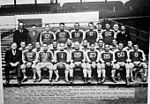Macombs Dam
1814 establishments in New York (state)Bridges completed in 1816Bridges in ManhattanBridges in the BronxBuildings and structures demolished in 1839 ... and 8 more
Concourse, BronxDams completed in 1814Dams in New York (state)Demolished bridges in the United StatesDemolished buildings and structures in ManhattanDemolished buildings and structures in the BronxFormer toll bridges in New York (state)Use mdy dates from April 2014

Macombs Dam ( mə-KOOMZ) was a dam and bridge across the Harlem River between Manhattan and the Bronx in New York City, which existed from c. 1814 to c. 1858. The bridge was later replaced with the toll-free Central Bridge, and since 1890, the current Macombs Dam Bridge has stood on the site.
Excerpt from the Wikipedia article Macombs Dam (License: CC BY-SA 3.0, Authors, Images).Macombs Dam
Macombs Dam Bridge, New York The Bronx
Geographical coordinates (GPS) Address Nearby Places Show on map
Geographical coordinates (GPS)
| Latitude | Longitude |
|---|---|
| N 40.828087 ° | E -73.933847 ° |
Address
Macombs Dam Bridge
Macombs Dam Bridge
10039 New York, The Bronx
New York, United States
Open on Google Maps




